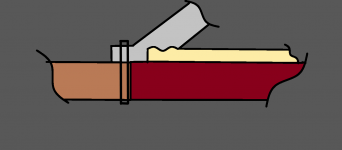Looking at this build, what are the advantages and disadvantages of insetting the woofer behind a mitered baffle, versus a standard flush-mount on the baffle front?
These are the Fleetwood Sound DeVilles. I am not asking about how anyone thinks these sound, or even knows they sound, or how they feel about the design. I'm looking for some objective information about why this may or may not be a good speaker design idea.
I think the woofer used is a B&C 8NDL51 (I imagine they have it customized somehow for their use in this speaker, but I don't know for sure). Aesthetically, this design certainly works well, as this woofer has a large, octagonal spider which might look unbecoming on the DeVille's cabinet.
Other than that, I'm interested in some real-world information on this design choice.
Thanks,
Brad
These are the Fleetwood Sound DeVilles. I am not asking about how anyone thinks these sound, or even knows they sound, or how they feel about the design. I'm looking for some objective information about why this may or may not be a good speaker design idea.
I think the woofer used is a B&C 8NDL51 (I imagine they have it customized somehow for their use in this speaker, but I don't know for sure). Aesthetically, this design certainly works well, as this woofer has a large, octagonal spider which might look unbecoming on the DeVille's cabinet.
Other than that, I'm interested in some real-world information on this design choice.
Thanks,
Brad
Attachments
I'm interested in what somebody who has measured/simulated the difference between your example vs a flush mount has found. My guess is that the two choices may trade diffraction issues vs frequency. It might be interesting to see a more gradual transition vs a simple 45 mitre. Something that could be produced on a shaper w/larger "raised panel" cutter.
Wanted to add that the design above would also gain a 3-4 dozen microseconds of time alignment w/the horn above as well. Could be that this was part of the engineers design choice.
Wanted to add that the design above would also gain a 3-4 dozen microseconds of time alignment w/the horn above as well. Could be that this was part of the engineers design choice.
Last edited:
In the old days there was back mounting as some of the baskets were not suited for flush mounting. The one in the picture, along with other reasons, might also be an attempt to more closely time align the drivers.
If the crossover frequency is low enough the driver won't even notice if its in front / behind the baffle.
Rob.
Rob.
If the crossover frequency is low enough the driver won't even notice if its in front / behind the baffle.
I believe the crossover point on these is somewhere around 1.5kHz. High frequencies are handled with a (I think) B&C (DE110 Neo maybe, assuming with tweaks) compression driver in that custom horn with a phase plug.
Does that mitered baffle cause any diffraction issues that would be audible?
I would expect some diffraction from the sharp edge. A roundover / smoother transition would be better.
Audible ? I don't know, but as the sharp edge is the same distance from the middle of the cone all the way round it should easily show up in a measurement.
Rob.
Audible ? I don't know, but as the sharp edge is the same distance from the middle of the cone all the way round it should easily show up in a measurement.
Rob.
At the low frequencies the woofer operates, it makes not a whit of difference. Make the choice based on visual appeal.
Nope. Look at the wavelength of a bass note in air, which is several feet. Not going to worry about an inch either way. Since the wavelength is so long, there's no horn effect caused by front baffle thickness, regardless of how you mount the subwoofer. For midranges or full rangers, then this becomes an issue. At low frequencies, the mass of the added air in the case of a rear mounted subwoofer is microscopic. Fuggeddabouddit. Mount the subwoofer any way you please.
For midranges or full rangers, then this becomes an issue. At low frequencies, the mass of the added air in the case of a rear mounted subwoofer is microscopic.
In the speaker I posted a photo of, the woofer play from about 50Hz to 1.5kHz, so I imagine there would be some diffraction effect. A 50Hz wave is too long for the baffle to matter for sure, but a 1.5kHz wave is only about 8.5 inches long. Is it still a negligible difference at that end of that frequency range?
Recall that as our eight inch driver rises in frequency approaching say 2K, the actual radiation surface creeps closer and closer towards the voice-coil...& the shape & curvatures of the cone start functioning as a horn structure itself.
There are no doubt some artifacts generated that could be measured by the most sensitive of equipment...but the resolution of the human ear couldn't detect them.
A safe bet would be to affix a self adhesive foam strip all around the inside circumference to absorb errant frequencies.
---------------------------------------------------------------------------Rick...
There are no doubt some artifacts generated that could be measured by the most sensitive of equipment...but the resolution of the human ear couldn't detect them.
A safe bet would be to affix a self adhesive foam strip all around the inside circumference to absorb errant frequencies.
---------------------------------------------------------------------------Rick...
The looks can be so important some audio qualities can be sacrificed. There must be some diffraction due to the woofer mounting scheme, but so there is in many other loudspeakers because of sharp edges on wide baffles. The looks is very important sales argument, and the linked product is very much about the looks.
- Home
- Loudspeakers
- Multi-Way
- Inset woofer

